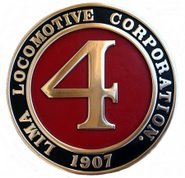
Dale used a set of heavy duty pipe clamps to bend the truss rods in place.
 Dale and Eric installed four truss rods on the Tally-Ho Railbus trailer on Saturday, May 20, 2006.
Dale and Eric installed four truss rods on the Tally-Ho Railbus trailer on Saturday, May 20, 2006.

Dale used a set of heavy duty pipe clamps to bend the truss rods in place.
 Dale and Eric installed four truss rods on the Tally-Ho Railbus trailer on Saturday, May 20, 2006.
Dale and Eric installed four truss rods on the Tally-Ho Railbus trailer on Saturday, May 20, 2006.
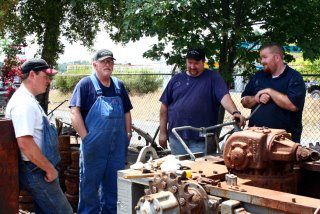 The valley crew made its long trek into the El Dorado Gold Country from Sacramento last Saturday to continue work on Arnold Z, El Dorado Western Railway's Plymouth switcher.
The valley crew made its long trek into the El Dorado Gold Country from Sacramento last Saturday to continue work on Arnold Z, El Dorado Western Railway's Plymouth switcher.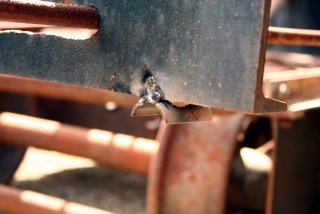 Dale's first task Saturday was to replace the two missing truss rod guides. Both missing guides were from the undercarriage.
Dale's first task Saturday was to replace the two missing truss rod guides. Both missing guides were from the undercarriage.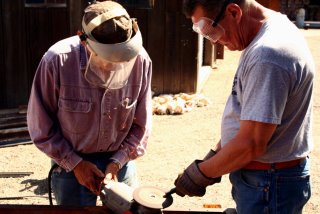 Next, Eric ground the unthreaded end of the both rods. Dale created a mobile grinding wheel by holding the heavy duty grinder while Eric tapered the rod ends.
Next, Eric ground the unthreaded end of the both rods. Dale created a mobile grinding wheel by holding the heavy duty grinder while Eric tapered the rod ends.
 The tapered end of the turnbuckle bolt.
The tapered end of the turnbuckle bolt.  Dales uses a piece of angle iron to line the two pieces. He tacks the toe pieces to hold them in place, then completes the weld elsewhere.
Dales uses a piece of angle iron to line the two pieces. He tacks the toe pieces to hold them in place, then completes the weld elsewhere.(Another nine or 10 other Shays reside within driving distance of the El Dorado Western engine house, according to ShayLocomotive.com's list of surviving Shays. A total of 116 Shay geared locomotives are known to have survived, along with 20 Climaxes (HeislerLocomotive.com) and 34 Heislers (SteamLocomotive.com).)
For a month now, I've been contemplating a summer vacation at Odell Lake in the Oregon's Cascade mountain range. A quick scan of the Internet led me to the May 1996 issue of TRAINS Magazine, which carried an article that maps the best spots to photograph former SP and Amtrak trains crossing the range. (The vacation didn't begin as a railroad trip -- it evolved once I discovered that the UP line passed along the south shore of the lake.)
Like any railroader, I dove into the rest of the issue and discovered a 10-year old piece on the geared workhorses of the mid-1990s ("Getting it in gear: Shays, Climaxes, and Heislers do more than their share of work in today's steam world," pages 34-39).
Author Jim Wrinn reasons that "good genetics" helped geared engines run so well a decade ago. That's the legacy of the Shay, Climax and Heisler. They were built to steam in rough mountains on poorly ballasted rails where "agility, brute strength, and simplicity of design were primary virtues."
Wrinn said that geared "engines worked on steep grades, flimsy temporary track with little or no maintenance, out in the wilderness far from the shops." That's why they survived. Any locomotive that was built for the arduous conditions of the forest was bound to outlive their mainline brothers.
Approximately 174 of the nearly 4,500 geared engines built from the late-1880s through to World War II are still with us today. That means about one of every 26 geared locomotives ever built is still with us (the ratio is 1:21 for the Shay). Twenty-one of the 116 surviving Shay operate today.
What's the survival record for rod engines? I'm not sure. But, I can say that only 1 in 300 Baldwin locomotives are still with us. According to Wrinn, over 60,000 locomotives were manufactured by Baldwin Locomotive Works (including five geared engines!).
Keith is right. Geared locomotives did survive in greater numbers that their mainline cousins. It's certainly a testament to their rugged design and ability to endure rough, often brutal conditions of the forest.
Come watch the El Dorado Western restore Lima Shay number 1986, the Diamond & Caldor No. 4. We're slowly restoring the largest of the two surviving El Dorado County logging locomotives and need the support of local citizens and railfans. We appreciate the help the we receive from the local El Dorado County community.
 I stopped by the engine house this morning for a few hours. There wasn't much going on as this is the "off" weekend. In the photo Dave Spohr (left) and Eric Stohl discuss the driveshaft renovation project.
I stopped by the engine house this morning for a few hours. There wasn't much going on as this is the "off" weekend. In the photo Dave Spohr (left) and Eric Stohl discuss the driveshaft renovation project.This morning, Eric Stohl and Dale Mace were installing the final corner brace for the Shay. When I left at 11 a.m., Dale was welding the joint between the base plate and the rod. The brace project will be done once Eric and Dale install the brace.
 Of the six braces, three were completely fabricated by Dale. Only three original braces were found when found when the crew started this project some 12 or 13 years ago. Dale and Eric were able to install two of the original braces without any modification. The third was modified some.
Of the six braces, three were completely fabricated by Dale. Only three original braces were found when found when the crew started this project some 12 or 13 years ago. Dale and Eric were able to install two of the original braces without any modification. The third was modified some.
Sam Thompson continued building his valve shaper in the machine shop. Dave Spohr was milling one of the short male drive stafts at the other end of the shop (see photo to left).
The Shay geared locomotive used a line shaft to drive the right wheel on each axel set. ShayLocomotives.com describes this unique arrangement:
These line shafts were attached to square shafts through couplings. The square shafts slid into sleeve shafts, which were attached to the crankshaft through another set of couplings. The square shaft sliding freely in the sleeve shaft allowed the locomotive to take sharp curves. As the truck turned to follow the track curve, the distance between the crankshaft and the truck increased or decreased and the square shaft slid in or out while still rotating, delivering power to the truck from the pistons.
Keith Berry described the restoration process in the spring issue of the newsletter:
Dave [has been working with Sam and Dale since February to restore the male] driveshaft faces to specification. Over normal locomotive operation, surface-to-surface friction from turning and the constant presence of dirt kicked up from the ballast ground the driveshaft faces down.
Sam's challenge was to locate an arbitrary starting surface point to weld/build the contact surfaces and end up with a four-sided square drive shaft. Once established, Dale welds, and Dave mills the surfaces. Then Dale welds, and Dave again mills, and around it goes. Or in this case, square it becomes! Eventually, the shaft will reach finished specification and they'll start on the next shaft.
 In the photo to the right, Dave used a fly cutter to shave 0.045-inch off the face of the shaft. Dale can only add metal to two surfaces at a time. One of the milled surfaces is used to lay the shaft level on the milling machine. The other is used as a gauge.
In the photo to the right, Dave used a fly cutter to shave 0.045-inch off the face of the shaft. Dale can only add metal to two surfaces at a time. One of the milled surfaces is used to lay the shaft level on the milling machine. The other is used as a gauge.
Dave feeds the surface being cut at a rate of 3/8-inch per minute. It takes 50 minutes to mill each surface.
Dave said Dale would ultimately add metal to edges so that he could form a true edge on the shaft. The edges take most of the punishment as the shaft slides in and out of the companion driveshaft.
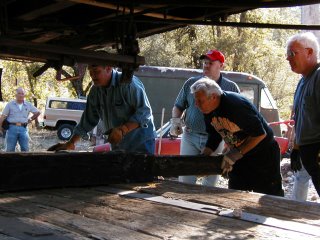 Ron (with gold lettering on T-shirt) helps Eric Stohl position an old tie during the D&RG boxcar move last October. The ties formed the crib that will support the boxcar on the flatbed trailer during the move. Vice President Keith Berry stands to the right of Ron.
Ron (with gold lettering on T-shirt) helps Eric Stohl position an old tie during the D&RG boxcar move last October. The ties formed the crib that will support the boxcar on the flatbed trailer during the move. Vice President Keith Berry stands to the right of Ron.
Steve Karoly at work in the museum research room. Since I take few photos of myself, I had to coach my 14-year old son to frame this shot.
Ron's departure has provided an opportunity for me to serve on the board. At the meeting, President Eric Stohl suggested that I be appointed to fill Ron's term. I'll continue to serve as newsletter editor, grant writer and all-around gofer. My personal thanks to Eric for his trust in my abilities.
As I write this, the guys are hard at work at the engine house. I'm sure Eric and Dale are installing the last corner brace on the Shay. Garrett, Ken and Scott should be removing another bearing from the Plymouth. And I expect that Sam, Dave and Bill are in the machine shop while Keith is helping where needed.
I'm heading out of town but will leave an update after I talk to Eric and Keith. More to come ...
 "A Fair to Remember" is the theme for the 2006 El Dorado County Fair, to be held at the El Dorado County Fairgrounds, June 16-18, 2006. The fairgrounds is located at 100 Placerville Drive, Placerville, California.
"A Fair to Remember" is the theme for the 2006 El Dorado County Fair, to be held at the El Dorado County Fairgrounds, June 16-18, 2006. The fairgrounds is located at 100 Placerville Drive, Placerville, California.Call for general information:
(530) 621-5865
Workdays and work locations vary during the week. Please contact the crew via Facebook if you'd like to volunteer. You can also stop by the museum.
El Dorado County Historical Museum
104 Placerville Drive
Placerville, CA 95667
To join our effort to renovate the Diamond and Caldor Railway No. 4 Shay locomotive and to build and operate an El Dorado County Historical Railroad Park, send $35 (check or money order) for individual membership the Diamond Springs address. Other membership options include:
Family membership $60
Corporate membership $100
Life membership $500 for individual/family
Business life membership $1,000
Annual membership runs from January to December.
